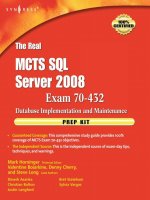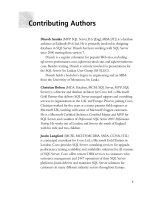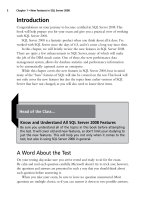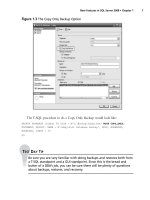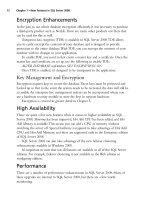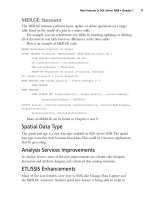The Real MTCS SQL Server 2008 Exam 70/432 Prep Kit- P7The Real MTCS SQL Server 2008 Exam 70/432 Prep Kit- P7 doc
Bạn đang xem bản rút gọn của tài liệu. Xem và tải ngay bản đầy đủ của tài liệu tại đây (251.31 KB, 5 trang )
12 Chapter1•NewFeaturesinSQLServer2008
Encryption Enhancements
In the past, to use whole database encryption efficiently, it was necessary to purchase
a third-party product such as NetLib. There are many other products out there that
can be used for this as well.
Transparent data encryption (TDE) is available in SQL Server 2008.TDE allows
you to easily encrypt the contents of your database and is designed to provide
protection to the entire database. With TDE, you can encrypt the contents of your
database with no changes to your application.
To enable TDE, you need to first create a master key and a certificate. Once the
master key and certificate are set up, use the following to enable TDE:
ALTER DATABASE myDatabase SET ENCRYPTION ON
Once TDE is enabled, it’s designed to be transparent to the application.
Key Management and Encryption
Encryption requires keys to secure the database. These keys must be protected and
backed up so that in the event the system needs to be recreated, the data will still be
accessible. An enterprise key management system can be incorporated where you
use a hardware security module to store the keys in separate hardware.
Encryption is covered in greater detail in Chapter 5.
High Availability
There are quite a few new features when it comes to higher availability in SQL
Server 2008. Mirroring has been improved, Hot Add CPU has been added, and Hot
Add Memory is available. This means you can add a CPU or memory without
switching the server off. Special hardware is required to take advantage of Hot Add
CPU and Hot Add Memory, and these are supported only in the Enterprise edition
of SQL Server 2008.
SQL Server 2008 can also take advantage of the new failover clustering
enhancements available in Windows 2008.
It’s important to note that not all features are available in all of the SQL Server
editions. For example, failover clustering is not available in the Web edition or
workgroup edition.
Performance
There are a number of performance enhancements in SQL Server 2008. Many of
these upgrades are internal to SQL Server 2008, but there are a few worth
mentioning.
NewFeaturesinSQLServer2008•Chapter1 13
Performance Data Management
Performance data management is a new tool available in SQL Server 2008.
Performance data management allows you to collect performance-related data from
your SQL Servers over time. Performance data management consists of a warehouse
database (for storing the results) and the data collector, and collection is usually
scheduled to run at specific times.
Resource Governor
(similar to Query Governor)
Resource Governor is a nice new feature to help manage workload, designed to limit
the resources available to a process. The way the Resource Governor works is the
DBA creates a workload group and a resource pool. Workload groups are containers
to hold user sessions. Workload groups are mapped to resource pools.
User sessions are mapped to workload groups based on classifier functions.
The classifier functions can be by IP address, username, application name, and so on.
Figure 1.5 shows at a high level how it all fits together.
Figure 1.5
Managing a Workload with Resource Governor
Connections
Classification
Function
Default
Group
Group A
Group B
Group C
Default
Pool
Pool 1
Pool 2
14 Chapter1•NewFeaturesinSQLServer2008
Freeze Plan
Freeze plan is a cool (pardon the pun) new feature in SQL 2008. Plan freezing is
meant to offer greater predictability when it comes to executing a particular query
in SQL Server 2008.
By executing a few lines of code, you can create a plan guide, which is basically
a cached plan that is kept around and used for a particular query.
First, you need to create the data warehouse, which is fairly easy. There’s a wizard
that will guide you through the steps in the management console. The wizard’s
main dialog is shown in Figure 1.6.
Figure 1.6 Creating a Data Warehouse
The actual how to is found later in this book; it’s worthwhile knowing how to
use this new feature.
Figure 1.7 is a sample of one of the reports available in the data collection set.
NewFeaturesinSQLServer2008•Chapter1 15
As you can see, this report can be useful. It provides quite a bit of information
about your databases and their size and growth.
Unfortunately, the data collection can be used only on SQL Server 2008 servers.
It will not work if you connect to a SQL 2005 or SQL 2000 database server.
SQL Server 2008
Declarative Management Framework
Another exciting new feature in SQL Server 2008 is the Declarative Management
Framework (DMF). This is basically a new policy-based management system for
SQL Server 2008.
The DMF is very similar to Windows policy; however, it’s much more focused on
SQL Server specifics. For example, you can enforce a particular naming convention
for stored procedures and a different naming convention for tables.
There are three main components to the DMF: policies, conditions, and facets.
See Figure 1.8.
Figure 1.7 A Data Collection Report
16 Chapter1•NewFeaturesinSQLServer2008
To create or apply a policy, you would right click on the policy node and
proceed from there. In the following screens, you’ll be prompted to use facets
and conditions to create a policy.
Development Improvements
Now we’ll discuss a few development improvements that were made to SQL
Server 2008.
LINQ Support
LINQ is a new technology. It’s more of a programming language than T-SQL.
It’s basically a mapping of the database object to programming objects. This
allows for a more object-oriented approach to dealing with database objects than
in the past. This is a cool new feature and is covered in greater detail later on
in this book.
Figure 1.8 DMF Components
